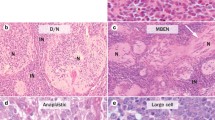Abstract
Case description
In this paper, we present a case of a 4-year-old male diagnosed with a desmoplastic, SHH-type medulloblastoma. Retrospectively, we discovered that the patient underwent an MRI scan at 21 months for reasons unrelated, revealing a T1-enhanced lesion at the vermis, later recognized as the source of the tumor. This unique case provides us with a glimpse into the natural history of this tumor. Our ability to measure tumor volume at two defined time points, 31 months apart, enabled us to deduce the tumor’s doubling time. This is defined as the time of one cell cycle divided by the amount of cycling cells, multiplied by cell loss factor. Potential doubling time (Tpot) and actual doubling time (Td), calculated using the Gompertzian model, are the most clinically relevant with regard to a tumor’s response to radiotherapy. Here, we show an actual doubling-time (Td) of 78 days, and an extrapolated tumor diameter at the time of birth of 0.25 mm.
Clinical relevance
These results both support the medulloblastoma’s embryonic origin, and indicating a threefold longer actual doubling time when compared to previous studies. Taking into account the reported range of medulloblastoma potential doubling time, we deduced a cell loss factor of between 48.9 and 95.5 %. These percentages fall in line with other malignant tumors. Although limited due to the obvious reliance on only two points in time and using the Gompertzian model to complete the remainder, to the best of our knowledge, this is the longest follow-up period reported for medulloblastoma.
Summary
We have described how a unique turn of events enabled us to get a glimpse into the in situ development of a medulloblastoma over a 31-month period. Regarded sometimes as an idiosyncratic tumor comprised of an array of molecular changes, the complexity of medulloblastoma is displayed here, by revealing for the first time an actual doubling time three- to fourfold the previously known length.


Similar content being viewed by others
References
Amacher AL, Torres Q, Rittenhouse S (1986) Congenital medulloblastoma: an inquiry into origins. Childs Nerv Syst 5:262–265
Aruga J, Yokota N, Hashimoto M, Furuichi T, Fukada M, Mikoshiba K (1986) A novel zinc finger protein, zic, is involved in neurogenesis, especially in the cell lineage of cerebellar granule cells. J Neurochem 63:1880–1890
Bacon S, Clinkard J, Taylor RE (2005) Paediatric medulloblastoma associated with poor prognosis and short volume doubling time. Br J Radiol 10(correspondence):1059–1060
Buhren J, Christoph AH, Buslei R, Albrecht S, Wiestler OD (2000) Expression of the neurotrophin receptor p75NTR in medulloblastomas is correlated with distinct histological and clinical features: evidence for a medulloblastoma subtype derived from the external granule cell layer. J Neuropathol Exp Neurol 59:229–240
Ellison D (2002) Classifying the medulloblastoma: insights from morphology and molecular genetics. Neuropathol Appl Neurobiol 28:257–282
Furneaux CE, Marshall ES, Yeoh K, Monteith SJ, Mews PJ, Sansur CA, Oskouian RJ, Sharples KJ, Baguley BC (2008) Cell cycle times of short-term cultures of brain cancers as predictors of survival. Br J Cancer 99:1678–1683
Gajjar A, Hernan R, Kocak M, Fuller C, Lee Y et al (2004) Clinical, histopathologic, and molecular markers of prognosis: toward a new disease risk stratification system for medulloblastoma. J Clin Oncol 22:984–993
Gibson P, Tong Y, Robinson G, Thompson MC, Spencer C, Eden C, Kranenburg TA, Hogg T, Poppleton H, Martin J, Finkelstein D, Pounds S, Weiss A, Patay Z, Scoggins M et al (2010) Subtypes of medulloblastoma have distinct developmental origins. Nature 468:1095–1099
Gilbertson RJ, Ellison DW (2008) The origins of medulloblastoma subtypes. Annual Rev Pathol Mech Dis 3:341–365
Hoshino T, Ito A, ASAI A, Shibuya M, Prados MD, Dodson BA, Davis RL, Wilson CB (1992) Cell kinetic analysis of human brain tumors by in situ double labeling with bromodeoxyuridine and iododeoxyuridine. Int J Cancer 50:1–5
Myers S, Camp S, Tarr R (1992) MR imaging features of medulloblastomas. AJR 158:859–865
Schwartz M (1961) A biomathematical approach to clinical tumor growth. Cancer 14:1272–1294
Steel GG (1968) Cell loss from experimental tumours. Cell Tissue Kinetics 1:193–207
Trojanowski JQ, Takashi T, Lee VMY (1992) Medulloblastomas and related primitive neuroectodermal brain tumors of childhood recapitulate molecular milestones in the maturation of neuroblasts. Mol Chem Neuropathol 17:121–135
Tubiana M, Malaise E (1976) Comparison of cell proliferation kinetics in human and experimental tumors: response to irradiation. Cancer Treat Rep 60:1887–1895
Yamashita T, Kuwubara T (1983) Estimation of rate of growth of malignant brain tumors by computed tomography scanning. Surg Neurol 20:464–470
Author information
Authors and Affiliations
Corresponding author
Ethics declarations
Conflict of interest
All authors certify that they have no affiliations with or involvement in any organization or entity with any financial interest (such as honoraria; educational grants; participation in speakers’ bureaus; membership, employment, consultancies, stock ownership, or other equity interest; and expert testimony or patent-licensing arrangements), or non-financial interest (such as personal or professional relationships, affiliations, knowledge or beliefs) in the subject matter or materials discussed in this manuscript.
Informed consent
Written informed consent was obtained from the patient for the publication of this report and any accompanying images.
Rights and permissions
About this article
Cite this article
Doron, O., Zauberman, J. & Feldman, Z. A medulloblastoma showing an unusually long doubling time: reflection of its singular nature. Childs Nerv Syst 32, 1153–1156 (2016). https://doi.org/10.1007/s00381-015-2997-7
Received:
Accepted:
Published:
Issue Date:
DOI: https://doi.org/10.1007/s00381-015-2997-7




